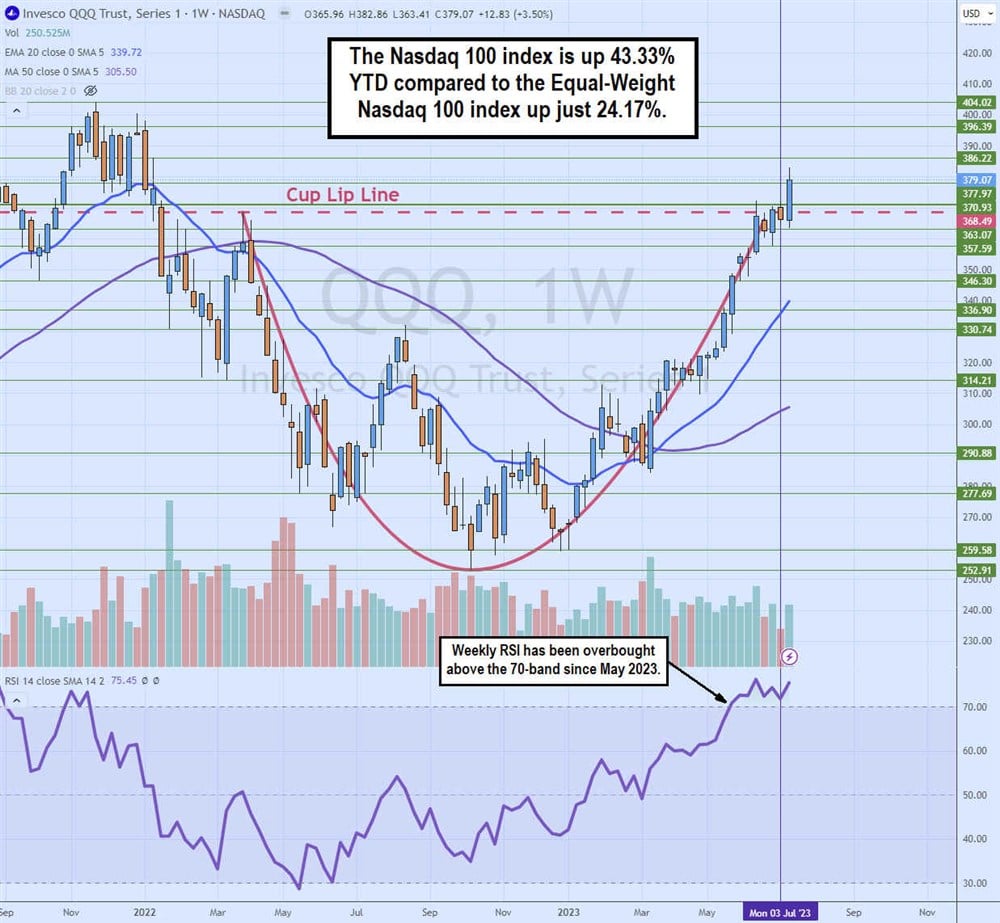On July 7, 2023, the Nasdaq announced it would implement a special rebalancing for the Nasdaq 100 index, tracked by the Invesco QQQ ETF NASDAQ: QQQ effective after hours on July 21, 2023, and pre-market on July 24, 2023. It will be based on the index securities closing prices and outstanding shares as of July 3, 2023. The spotlight has been drawn on the index's seven heaviest-weighted stocks, dubbed the Magnificent Seven.
They account for 55% of the Nasdaq 100 index. The Nasdaq will adjust the weightings, not add or remove stocks from the index. What does this mean for the indexes?
Special Rebalancing Parameters
The Nasdaq regularly rebalances the index every quarter. The rally in Tesla Co. NASDAQ: TSLA triggered the special rebalancing, pushing the aggregate weighting of the largest stocks over 48%. Of course, Tesla can't be completely blamed as the other company stocks have all risen, contributing towards the 48% threshold break.
The Nasdaq can conduct a special rebalancing when the aggregate weight of its index stocks with more than a 4.5% index weighting exceeds 48%. The rebalancing aims to drop the market cap weighting to 40% while no other stock weightings can exceed 4.4%. The five heaviest-weighted stocks were Microsoft Co. NASDAQ: MSFT, Apple Inc. NASDAQ: AAPL, Nvidia Co. (NASDAQ NVDA), Amazon.com NASDAQ: AMZN) and Tesla. Alphabet Inc. NASDAQ: GOOGL and Meta Platforms Inc. NASDAQ: META round out the Magnificent Seven.
What Does it Mean?
The aggregate weight of the subset of issuers whose weights exceed 4.5% will be set to 40% using a reference date of the end of day July 3rd, 2023.. Weightings will increase on smaller market cap stocks. It's spreading the investments to improve the breadth and not be concentrated in the heaviest-weighted stocks.
Nasdaq will release the changes to the Nasdaq 100 index weightings, including which stocks will be downsized and which will be upsized.
What’s the Impact on Returns?
The weighting adjustments will have an impact on the Nasdaq 100 performance. The initial result will likely be a pullback in performance as it sheds some of the best-performing stocks to date. The question is whether the effects from the upsized stocks will offset the effects on the downsized stocks in the final calculation of the index on the close of July 24, 2023.
Expect Nasdaq 100 Performance to Adjust Lower
In other words, the 43.33% year-to-date (YTD) returns on the QQQ will likely be lower when the smoke clears after the rebalance. Compare the current Nasdaq 100 QQQ ETF gains of 43.33% as of July 16, 2023, with the First Trust Equal Weighted Nasdaq 100 Index Fund NASDAQ: QQEW gains of just 24.17%. The rebalancing will not result in an equal-weighted Nasdaq 100, but it will likely dilute some YTD performance to fall between the 43.33% and 24.17% performance range.
Is the S&P 500 Next?
All this leads to whether the S&P 500 index, tracked by the SPDR S&P 500 ETF Trust NYSEARCA: SPY, will follow along with its special rebalancing. Under current weightings, the heaviest market cap-weighted stocks in the index have yet to cross the threshold.
The S&P 500 index rebalancing occurs when stocks heavier than 4.8% weight cumulatively exceed the 50% threshold of the total index. Only AAPL at 7.47% and MSFT at 6.76% weighting exceed the 4.8% threshold to qualify for the aggregate total surpassing 50%. The third heaviest market cap is AMZN, with a 3.18% weighting.
Technically, there would be no need to rebalance the S&P 500 index, up 17.98% YTD. This overconcentration is a Nasdaq 100 issue, not an S&P 500 problem. However, that may not be the case when compared to the Invesco S&P 500 Equal Weight ETF NYSEARCA: RSP YTD performance of just 7.75%, less than half of the S&P 500 index gains.

Weekly Cup Formation Pattern
The weekly QQQ (Nasdaq 100 ETF) chart illustrates an impressive recovery to complete the cup formation. The cup started after peaking a rally attempt at $368.97 in March 2022. The QQQ sank to a low of $252.91 in October 2022. It formed a rounding bottom, gradually accelerating higher to retest the $368.97 cup line and breakout to a high of $382.86 in July 2023. The all-time high sits at $404.02, achieved in November 2021.
The relative strength index (RSI) oscillator is overbought at the 75-band. In fact, it's been overbought since breaking through the 70-band in May 2023 when it was priced in the $330-$340 range. A reversion back under the cup lip line would form a handle, followed by a breakout through the cup line again would complete a cup and handle formation.
Before you consider Invesco QQQ, you'll want to hear this.
MarketBeat keeps track of Wall Street's top-rated and best performing research analysts and the stocks they recommend to their clients on a daily basis. MarketBeat has identified the five stocks that top analysts are quietly whispering to their clients to buy now before the broader market catches on... and Invesco QQQ wasn't on the list.
While Invesco QQQ currently has a Hold rating among analysts, top-rated analysts believe these five stocks are better buys.
View The Five Stocks Here
If a company's CEO, COO, and CFO were all selling shares of their stock, would you want to know? MarketBeat just compiled its list of the twelve stocks that corporate insiders are abandoning. Complete the form below to see which companies made the list.
Get This Free Report
Like this article? Share it with a colleague.
Link copied to clipboard.